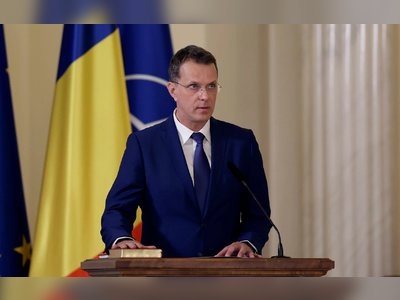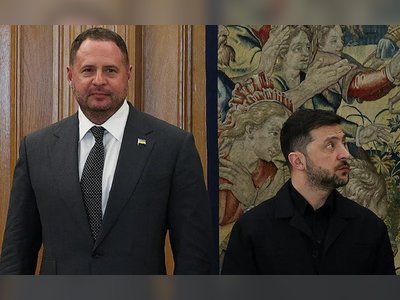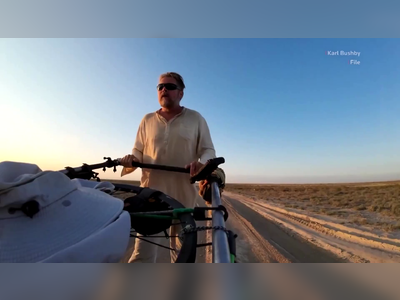Iranian Islamic Revolution 45 Years Later, Blessing or Curse?
In 1979, when Ayatollah Khomeini returned from his exile in Western Europe and proclaimed the establishment of the Islamic Republic of Iran, the country was undergoing the rule of Shah Reza Pahlavi.
This raises the question: was the fall of the Shah's regime necessary, and if so, why? According to Maria Bordas, the Shah’s system collapsed remarkably quickly following the Iranian revolution. Iran became the first state in the Islamic world to be built on the principles of radical Islam after the revolution. The victory of the Iranian revolution shocked the Western world, which has since considered it one of the CIA's greatest miscalculations, as the agency predicted that the Shah would remain in power for a long time despite the mass movements that emerged as early as 1977.
The fall of Mohammad Reza Pahlavi's regime was not inevitable, even though the Shah's secret police (SAVAK) operated a brutal oppressive system since dictatorships were common throughout the Middle East at that time. Shah Pahlavi saw Kemal Ataturk, who successfully modernized Turkey in the early 20th century - currently the only secular Islamic state - as a role model. Following this example, the Shah instituted a constitution and secularized the state in Iran.
However, the Shah’s social reforms were implemented with considerable contradiction. As part of land reform, the Shah nationalized the huge estates of Shiite religious leaders, aimed at abolishing feudal relations and securing land for the peasantry. This did not lead to economic development due to a lack of capital investment, and the smallholdings of the peasantry failed, leading to mass migration to the cities. Concurrently, food prices rose as agriculture had to rely on imports to meet increasing demand due to its inefficiency.
Politically, by nationalizing the lands of Shiite religious leadership, the Shah gained a formidable opponent: the clergy successfully turned the mood of the masses against the Shah and later took the lead in mass demonstrations that began in 1977, culminating in the revolution. This process was reinforced by the fact that a large number of young Shiite religious fanatics emerged from Islamic schools (madrasas) during this time, who later became supporters of the Iranian religious leadership the expert emphasized.
Despite the resolution of feudal relations and rapid urbanization in the long term, these developments contributed to economic growth. Unemployment remained low because industrial development absorbed the workforce that migrated from the countryside to the cities. Besides economic achievements, the Shah also successfully reformed education and healthcare. Women's rights were recognized; women gained the right to vote, the traditional Islamic dress (hijab) was banned, and women were allowed to study and work, thus starting to follow Western patterns.
During this period, oil revenues greatly contributed to the increase in per capita national income. Despite the Iranian oil concessions being in the hands of British business ventures, the state budget secured massive income. However, the Shah could not translate this into the welfare of the population, despite Iran being one of the richest countries in the Middle East in terms of oil and natural gas.
The wealth gap between the rich and the middle class widened, and the Shah’s regime was also unable to eradicate poverty. This was mainly due to the Shah’s ambition, influenced by Persian imperial nostalgia, to make Iran a regional superpower in the Middle East and his spending of billions on buying foreign weaponry. Additionally, the Shah crowned himself emperor, led a lavish lifestyle, and provided extravagances that increasingly disturbed the common people.
The discontent was further exacerbated by the repressive actions of the Shah’s secret police, SAVAK, which brutally suppressed the opposition, as well as ethnic and religious minorities: Arabs, Kurds, Tajiks, and Baluchis. The Iranian Shiite religious leadership skillfully exploited this to incite growing anti-Shah sentiments among the masses and led the mass demonstrations that later evolved into a revolution.
The criticism of the Shah's oppressive system was compounded by their anti-Western stance, claiming that the Shah had allowed a large number of American advisors into the country. The Shiite religious leadership promised the people a fairer society based on Islamic principles, to which the populace showed receptiveness. Islamic fundamentalism, which saw the solution to the modernization crisis of the Islamic world in Islamic traditions, was already quite widespread in the Middle East by the second half of the 20th century.
WHY DID AYATOLLAH KHOMEINI MANAGE TO CAPTIVATE THE PEOPLE, AND WHO WAS HE?
Ruhollah Khomeini was a highly educated ayatollah in the Shiite religion, who opposed the Shah's Western-friendly policies and Western trends in social life, such as the ban on women's hijab, women's equality, and the spread of Western entertainment. Along with the religious leadership of the time, the ayatollah also deemed this an attack against Islamic traditions. Khomeini vehemently opposed the Shah's economic and social reform program, the so-called "White Revolution," and began to personally attack the Shah in his speeches, announcements, and flyers, increasingly inciting against the Shah's regime. Consequently, the reform program failed in a referendum.
In response, the Shah exiled Khomeini from the country, first to Turkey, then to Iraq, and finally to France. During his stay in Iraq from the 1970s, Khomeini gained increasing popularity and operated an informal network through the assistance of the Iranian Shiite clergy, allowing him to send pamphlets and audio recordings into Iran. His success was significantly aided by the support of the Iranian opposition, the attention of the Western media, his puritan lifestyle, and charismatic personality. After SAVAK killed his son in 1977, his martyrdom further increased his popularity reminded the NKE professor.
In 1979, the Shah fled the country, then Khomeini returned home and took command of the revolution. Utilizing his popularity, he appointed himself as the supreme leader with unlimited power of the new Islamic state. With brutal terror tactics, he executed or imprisoned supporters of the Shah, the Western way of life, and modernization, then introduced medieval Islamic institutions: mandatory wearing of the hijab for women, the full deprivation of their rights, and Islamic courts.
The new constitution declared the Islamic republic as a new state form, which, while seemingly adopting many Western state institutions, in practice declared the unlimited power of the radical Shiite religious leadership.
After the victory of the Iranian revolution, Western citizens living in the country had to flee, and Western states had to face the loss of their oil concessions. Additionally, under Khomeini's orders, several hundred American hostages were held at the US embassy in Tehran. The American military made an unsuccessful attempt to free them, and later negotiations led to their release. Unsurprisingly, Iran quickly became an enemy of Western states, especially the United States.
THE SOVIET UNION ALSO DISLIKED THE NEW IRAN
Not only the Western alliance but also the Soviet Union was concerned about the establishment of the Iranian Islamic state. They feared that Muslims living in the Central Asian Soviet republics would easily radicalize as a result. Khomeini did not hide his intention to spread the Islamic revolution, starting with Iraq. Therefore, the Soviet Union supported the Iraqi dictator Saddam Hussein in the eight-year war between the two countries, which claimed the lives of hundreds of thousands on both sides.
From the outset, the new Iranian state was left without allies.
Due to its anti-Western stance and Islamic radicalism, it was not only considered an enemy by Western and socialist states but also became isolated in the Middle East. The traditional Sunni-Shiite rivalry with the Gulf monarchies, especially with Saudi Arabia, escalated into open confrontation. These countries represented the orthodox variant of Sunni Islam, which defended the stability of the power of the ruling dynasty, the religious leadership, and the council of elders (tribal leaders assembly). However, the radical Shiite Islamic view of the Iranian revolution was in stark contrast to this.
WHY DID IRAN BECOME A DESPOTIC, THEOCRATIC STATE?
Several factors contributed to this outcome, Maria Bordas explained. Khomeini, a learned and puritanical religious leader revered by the Iranian people as a saint, who promised the people a fairer society in contrast to the Shah's dictatorial rule, post-revolution became a Machiavellian power operator, suppressing all opposition groups and ethnic minorities with bloodied hands. He maintained this after the institutions of the new Iranian state had stabilized and taken on constitutional forms.
The Iranian revolution was built on the principles of radical Islam, which until the end of the 1970s, was mainly represented by the Muslim Brotherhood of Egypt. The later radical Islamic manifestations, such as Hamas in Gaza, Hezbollah in Lebanon, and later the Islamic State in Iraq and Syria, were not state entities but rather terrorist organizations operating as pseudo-states. However, the new Iranian state that emerged after the revolution has been recognized by the international community from the beginning. This also meant that it had sovereignty to decide on its political and state institutional system.
The expert also pointed out that a significant difference between the medieval Shiite Imamate and the Sunni Caliphate was that in the latter, the power of the caliph as a state leader was limited by the guarantee of religious leaders that the caliph's exercise of power didn't deviate from Islamic teachings, thus legitimizing the caliphate. The caliph had to consider the opinion of the tribal leaders' council as well. In the medieval Imamate established on Shiite Islamic principles, there were no institutions to limit power. The Shiite Islamic sect, which split from Sunnism one century after the death of Prophet Muhammad, still maintains that religious leaders concentrate all political and state power. This stems from the belief that only descendants of Muhammad can be religious leaders, possessing mystical knowledge and infallibility. Therefore, Shiite religious leadership cannot have opposition, as it would be opposing the teachings of Prophet Muhammad and Islam itself.
After the Iranian revolution, a peculiar political and governmental system emerged in Iran, effectively operating in the form of the Shiite Imamate. Additionally, it used Western democratic institutions, but their role is nominal, and their function, hollowed out. In this sense, the new Iranian state was predetermined to be founded not on democratic but dictatorial principles partly due to Khomeini's dictatorial aspirations and partly due to the traditions of the Shiite religious sect.
Its initial ideology was the preservation of the revolution's acquisitions, and today, the preservation of the traditions of the Shiite religion.
THE MEANS TO MAINTAIN POWER IN IRAN
After the revolution, a political-governmental system emerged in Iran where the religious leadership constructed its unlimited power. The Iranian constitution declares that supreme power is exercised by Allah, which implies that the exclusive holders of power are religious leaders. There are elections, a constitution, parliament, government, local self-government, etc., which means that, ultimately, every decision corresponds to the interests of the religious leadership. The absence of political pluralism guarantees this, as there are no political parties and only those nominated by the supreme religious leader can be elected to parliament.
The main possessor of power is the supreme religious leader (the first was Khomeini, currently Ali Khamenei), whose legitimacy is granted by his descent from Muhammad, possessing spiritual qualities, and representing the last, 12th Imam.
In the Shiite religious sect, people await the Mahdi (the savior), in whose image the last, lost Imam will appear. The supreme religious leader is not elected by the people, but by the Council of Experts representing religious leaders; the people simply accept him.
The supreme religious leader has unlimited power over political and state organizations, the military, courts, and secret services. Two thousand deputies represent him in local administration, where they have the right to intervene directly in any decision.
CONCENTRATION OF POWER IN IRAN
In addition to the aforementioned, several state institutions serve the concentration of power. Although the people elect the Council of Experts, which represents the leading religious class, its members are appointed by the supreme religious leader. The Council of Guardians supervises constitutionality, but its members are appointed by the supreme religious leader and the parliament. The President of the Republic is directly elected by the people, but only a candidate approved by the supreme religious leader can run. The President chooses the government members. The justice system is medieval, with only revolutionary and religious courts in operation.
The main guarantee of the Iranian religious leadership's power is the Islamic Revolutionary Guard Corps (IRGC), originally created by Khomeini to preserve the achievements of the revolution but later became the most important tool of terror over the population. Its elite unit is Quds (meaning Jerusalem), which carries out sabotage actions, assassinations, and supports and operates terrorist organizations both inside Iran and abroad.
The IRGC, as a political police force, also has unlimited rights to enforce religious regulations among the population. Over the past decade, they have brutally suppressed numerous street protests, executing or imprisoning participants – even issuing public hangings. They can check anyone at any time, anywhere, and have the right to kill anyone who violates religious protocols – for instance, if a woman's hijab does not fully cover her hair, or if they consume alcohol.
WHAT HAS CHANGED IN IRAN ECONOMICALLY OVER THE PAST 45 YEARS?
Despite its richness in oil and natural gas, Iran's economy provides low output. Partly because the Tehran government spends a great deal of money on financing and arming states and foreign organizations it supports. Western powers hit Iran with economic sanctions after failing to agree on nuclear development control, causing a serious economic crisis. The Iranian economy, much of which is owned by the Shiite religious leadership, the IRGC members, or state-run enterprises, does not operate on free-market principles, which further weakens its performance says the expert.
Corruption is also high in the state, as there is no checking mechanism that can restrict the religious leadership in this regard.
The financial system is disconnected from the international system, and the Iranian currency is not convertible. The legal and business environment necessary for a market economy is also poorly developed. The Tehran government currently faces a serious economic crisis for which it has no solutions.
The deteriorating economy has led to a drastic decrease in the population's standard of living. Opposition to the oppressive regime and turning away from the Iranian religious leadership are also due to the growing poverty. The populace feels deceived by the religious leadership, and believe that an even more unjust society with greater wealth inequalities than during the Shah's rule has been established.
The fall of Mohammad Reza Pahlavi's regime was not inevitable, even though the Shah's secret police (SAVAK) operated a brutal oppressive system since dictatorships were common throughout the Middle East at that time. Shah Pahlavi saw Kemal Ataturk, who successfully modernized Turkey in the early 20th century - currently the only secular Islamic state - as a role model. Following this example, the Shah instituted a constitution and secularized the state in Iran.
However, the Shah’s social reforms were implemented with considerable contradiction. As part of land reform, the Shah nationalized the huge estates of Shiite religious leaders, aimed at abolishing feudal relations and securing land for the peasantry. This did not lead to economic development due to a lack of capital investment, and the smallholdings of the peasantry failed, leading to mass migration to the cities. Concurrently, food prices rose as agriculture had to rely on imports to meet increasing demand due to its inefficiency.
Politically, by nationalizing the lands of Shiite religious leadership, the Shah gained a formidable opponent: the clergy successfully turned the mood of the masses against the Shah and later took the lead in mass demonstrations that began in 1977, culminating in the revolution. This process was reinforced by the fact that a large number of young Shiite religious fanatics emerged from Islamic schools (madrasas) during this time, who later became supporters of the Iranian religious leadership the expert emphasized.
Despite the resolution of feudal relations and rapid urbanization in the long term, these developments contributed to economic growth. Unemployment remained low because industrial development absorbed the workforce that migrated from the countryside to the cities. Besides economic achievements, the Shah also successfully reformed education and healthcare. Women's rights were recognized; women gained the right to vote, the traditional Islamic dress (hijab) was banned, and women were allowed to study and work, thus starting to follow Western patterns.
During this period, oil revenues greatly contributed to the increase in per capita national income. Despite the Iranian oil concessions being in the hands of British business ventures, the state budget secured massive income. However, the Shah could not translate this into the welfare of the population, despite Iran being one of the richest countries in the Middle East in terms of oil and natural gas.
The wealth gap between the rich and the middle class widened, and the Shah’s regime was also unable to eradicate poverty. This was mainly due to the Shah’s ambition, influenced by Persian imperial nostalgia, to make Iran a regional superpower in the Middle East and his spending of billions on buying foreign weaponry. Additionally, the Shah crowned himself emperor, led a lavish lifestyle, and provided extravagances that increasingly disturbed the common people.
The discontent was further exacerbated by the repressive actions of the Shah’s secret police, SAVAK, which brutally suppressed the opposition, as well as ethnic and religious minorities: Arabs, Kurds, Tajiks, and Baluchis. The Iranian Shiite religious leadership skillfully exploited this to incite growing anti-Shah sentiments among the masses and led the mass demonstrations that later evolved into a revolution.
The criticism of the Shah's oppressive system was compounded by their anti-Western stance, claiming that the Shah had allowed a large number of American advisors into the country. The Shiite religious leadership promised the people a fairer society based on Islamic principles, to which the populace showed receptiveness. Islamic fundamentalism, which saw the solution to the modernization crisis of the Islamic world in Islamic traditions, was already quite widespread in the Middle East by the second half of the 20th century.
WHY DID AYATOLLAH KHOMEINI MANAGE TO CAPTIVATE THE PEOPLE, AND WHO WAS HE?
Ruhollah Khomeini was a highly educated ayatollah in the Shiite religion, who opposed the Shah's Western-friendly policies and Western trends in social life, such as the ban on women's hijab, women's equality, and the spread of Western entertainment. Along with the religious leadership of the time, the ayatollah also deemed this an attack against Islamic traditions. Khomeini vehemently opposed the Shah's economic and social reform program, the so-called "White Revolution," and began to personally attack the Shah in his speeches, announcements, and flyers, increasingly inciting against the Shah's regime. Consequently, the reform program failed in a referendum.
In response, the Shah exiled Khomeini from the country, first to Turkey, then to Iraq, and finally to France. During his stay in Iraq from the 1970s, Khomeini gained increasing popularity and operated an informal network through the assistance of the Iranian Shiite clergy, allowing him to send pamphlets and audio recordings into Iran. His success was significantly aided by the support of the Iranian opposition, the attention of the Western media, his puritan lifestyle, and charismatic personality. After SAVAK killed his son in 1977, his martyrdom further increased his popularity reminded the NKE professor.
In 1979, the Shah fled the country, then Khomeini returned home and took command of the revolution. Utilizing his popularity, he appointed himself as the supreme leader with unlimited power of the new Islamic state. With brutal terror tactics, he executed or imprisoned supporters of the Shah, the Western way of life, and modernization, then introduced medieval Islamic institutions: mandatory wearing of the hijab for women, the full deprivation of their rights, and Islamic courts.
The new constitution declared the Islamic republic as a new state form, which, while seemingly adopting many Western state institutions, in practice declared the unlimited power of the radical Shiite religious leadership.
After the victory of the Iranian revolution, Western citizens living in the country had to flee, and Western states had to face the loss of their oil concessions. Additionally, under Khomeini's orders, several hundred American hostages were held at the US embassy in Tehran. The American military made an unsuccessful attempt to free them, and later negotiations led to their release. Unsurprisingly, Iran quickly became an enemy of Western states, especially the United States.
THE SOVIET UNION ALSO DISLIKED THE NEW IRAN
Not only the Western alliance but also the Soviet Union was concerned about the establishment of the Iranian Islamic state. They feared that Muslims living in the Central Asian Soviet republics would easily radicalize as a result. Khomeini did not hide his intention to spread the Islamic revolution, starting with Iraq. Therefore, the Soviet Union supported the Iraqi dictator Saddam Hussein in the eight-year war between the two countries, which claimed the lives of hundreds of thousands on both sides.
From the outset, the new Iranian state was left without allies.
Due to its anti-Western stance and Islamic radicalism, it was not only considered an enemy by Western and socialist states but also became isolated in the Middle East. The traditional Sunni-Shiite rivalry with the Gulf monarchies, especially with Saudi Arabia, escalated into open confrontation. These countries represented the orthodox variant of Sunni Islam, which defended the stability of the power of the ruling dynasty, the religious leadership, and the council of elders (tribal leaders assembly). However, the radical Shiite Islamic view of the Iranian revolution was in stark contrast to this.
WHY DID IRAN BECOME A DESPOTIC, THEOCRATIC STATE?
Several factors contributed to this outcome, Maria Bordas explained. Khomeini, a learned and puritanical religious leader revered by the Iranian people as a saint, who promised the people a fairer society in contrast to the Shah's dictatorial rule, post-revolution became a Machiavellian power operator, suppressing all opposition groups and ethnic minorities with bloodied hands. He maintained this after the institutions of the new Iranian state had stabilized and taken on constitutional forms.
The Iranian revolution was built on the principles of radical Islam, which until the end of the 1970s, was mainly represented by the Muslim Brotherhood of Egypt. The later radical Islamic manifestations, such as Hamas in Gaza, Hezbollah in Lebanon, and later the Islamic State in Iraq and Syria, were not state entities but rather terrorist organizations operating as pseudo-states. However, the new Iranian state that emerged after the revolution has been recognized by the international community from the beginning. This also meant that it had sovereignty to decide on its political and state institutional system.
The expert also pointed out that a significant difference between the medieval Shiite Imamate and the Sunni Caliphate was that in the latter, the power of the caliph as a state leader was limited by the guarantee of religious leaders that the caliph's exercise of power didn't deviate from Islamic teachings, thus legitimizing the caliphate. The caliph had to consider the opinion of the tribal leaders' council as well. In the medieval Imamate established on Shiite Islamic principles, there were no institutions to limit power. The Shiite Islamic sect, which split from Sunnism one century after the death of Prophet Muhammad, still maintains that religious leaders concentrate all political and state power. This stems from the belief that only descendants of Muhammad can be religious leaders, possessing mystical knowledge and infallibility. Therefore, Shiite religious leadership cannot have opposition, as it would be opposing the teachings of Prophet Muhammad and Islam itself.
After the Iranian revolution, a peculiar political and governmental system emerged in Iran, effectively operating in the form of the Shiite Imamate. Additionally, it used Western democratic institutions, but their role is nominal, and their function, hollowed out. In this sense, the new Iranian state was predetermined to be founded not on democratic but dictatorial principles partly due to Khomeini's dictatorial aspirations and partly due to the traditions of the Shiite religious sect.
Its initial ideology was the preservation of the revolution's acquisitions, and today, the preservation of the traditions of the Shiite religion.
THE MEANS TO MAINTAIN POWER IN IRAN
After the revolution, a political-governmental system emerged in Iran where the religious leadership constructed its unlimited power. The Iranian constitution declares that supreme power is exercised by Allah, which implies that the exclusive holders of power are religious leaders. There are elections, a constitution, parliament, government, local self-government, etc., which means that, ultimately, every decision corresponds to the interests of the religious leadership. The absence of political pluralism guarantees this, as there are no political parties and only those nominated by the supreme religious leader can be elected to parliament.
The main possessor of power is the supreme religious leader (the first was Khomeini, currently Ali Khamenei), whose legitimacy is granted by his descent from Muhammad, possessing spiritual qualities, and representing the last, 12th Imam.
In the Shiite religious sect, people await the Mahdi (the savior), in whose image the last, lost Imam will appear. The supreme religious leader is not elected by the people, but by the Council of Experts representing religious leaders; the people simply accept him.
The supreme religious leader has unlimited power over political and state organizations, the military, courts, and secret services. Two thousand deputies represent him in local administration, where they have the right to intervene directly in any decision.
CONCENTRATION OF POWER IN IRAN
In addition to the aforementioned, several state institutions serve the concentration of power. Although the people elect the Council of Experts, which represents the leading religious class, its members are appointed by the supreme religious leader. The Council of Guardians supervises constitutionality, but its members are appointed by the supreme religious leader and the parliament. The President of the Republic is directly elected by the people, but only a candidate approved by the supreme religious leader can run. The President chooses the government members. The justice system is medieval, with only revolutionary and religious courts in operation.
The main guarantee of the Iranian religious leadership's power is the Islamic Revolutionary Guard Corps (IRGC), originally created by Khomeini to preserve the achievements of the revolution but later became the most important tool of terror over the population. Its elite unit is Quds (meaning Jerusalem), which carries out sabotage actions, assassinations, and supports and operates terrorist organizations both inside Iran and abroad.
The IRGC, as a political police force, also has unlimited rights to enforce religious regulations among the population. Over the past decade, they have brutally suppressed numerous street protests, executing or imprisoning participants – even issuing public hangings. They can check anyone at any time, anywhere, and have the right to kill anyone who violates religious protocols – for instance, if a woman's hijab does not fully cover her hair, or if they consume alcohol.
WHAT HAS CHANGED IN IRAN ECONOMICALLY OVER THE PAST 45 YEARS?
Despite its richness in oil and natural gas, Iran's economy provides low output. Partly because the Tehran government spends a great deal of money on financing and arming states and foreign organizations it supports. Western powers hit Iran with economic sanctions after failing to agree on nuclear development control, causing a serious economic crisis. The Iranian economy, much of which is owned by the Shiite religious leadership, the IRGC members, or state-run enterprises, does not operate on free-market principles, which further weakens its performance says the expert.
Corruption is also high in the state, as there is no checking mechanism that can restrict the religious leadership in this regard.
The financial system is disconnected from the international system, and the Iranian currency is not convertible. The legal and business environment necessary for a market economy is also poorly developed. The Tehran government currently faces a serious economic crisis for which it has no solutions.
The deteriorating economy has led to a drastic decrease in the population's standard of living. Opposition to the oppressive regime and turning away from the Iranian religious leadership are also due to the growing poverty. The populace feels deceived by the religious leadership, and believe that an even more unjust society with greater wealth inequalities than during the Shah's rule has been established.
AI Disclaimer: An advanced artificial intelligence (AI) system generated the content of this page on its own. This innovative technology conducts extensive research from a variety of reliable sources, performs rigorous fact-checking and verification, cleans up and balances biased or manipulated content, and presents a minimal factual summary that is just enough yet essential for you to function as an informed and educated citizen. Please keep in mind, however, that this system is an evolving technology, and as a result, the article may contain accidental inaccuracies or errors. We urge you to help us improve our site by reporting any inaccuracies you find using the "Contact Us" link at the bottom of this page. Your helpful feedback helps us improve our system and deliver more precise content. When you find an article of interest here, please look for the full and extensive coverage of this topic in traditional news sources, as they are written by professional journalists that we try to support, not replace. We appreciate your understanding and assistance.














